Hesperia (1885-1959), was one of the Italian divas of the silent screen. In her films, she could get into uncontrollable rages but also into wildly merry moods. Hesperia often worked with director Baldassarre Negroni, who later became her husband. In later life, the formerly 'dishonoured woman' whose family had once closed the door to her because of her vaudeville career, became a countess.

Italian postcard by Ed. A. Traldi, Roma. Photo: Pinto, Roma.

Romanian postcard by Edition S.A.R.P.I.C., Bucharest, no. 52.


Italian postcard by Ed. A. Traldi, Roma. Photo: Pinto, Roma.

Romanian postcard by Edition S.A.R.P.I.C., Bucharest, no. 52.

Italian postcard by Ed. A. Traldi, Milano, no. 465.

Italian postcard by Ed. Fotocelere, Torino, no. 209.

Italian postcard by Ed. Fotocelere, Torino, no. 216.
Tableaux vivants
Hesperia was born as Olga Mambelli in 1885 in Bertinora, Italy. Her niece was film actress Pauline Polaire, who also appeared in Italian silent films.
Hesperia started her career as a child actor at the Teatro Comunale, the local theatre in Meldola in the Italian Romagna, where she grew up.
Between 1910 and 1912 she had her breakthrough as a Vaudeville artist with tableaux vivants of sculptures and paintings, performing all around Italy. Her parents considered her hence a dishonoured woman and closed the door to her.
Baron Fassini of the Roman Cines film company saw a future star in this quite matron-like woman. He put her into films, first in two- and three-reelers, often paired with Ignazio Lupi.
Among these early films were silent shorts like Quando la donna vuole.../When the Woman Wants... (N.N., 1912), Altruismo/Altruism (N.N., 1912), and La madre/The Mother (Baldassarre Negroni, 1913) with Leda Gys. Hesperia proved to be as well a good dramatic actress as a comedienne.

Spanish collector card by Reclam Films, Mallorca, no. 3 of 6 cards. Photo: Cines. Hesperia saves her daughter from the evil Casuli (Ugone Di Sandri) in Fra uomini e belve (Avventure in India)/Between Savage and Tiger (Giulio Antamoro, 1913).

Spanish collector card by Edics. y Publics. de Arte L. Planas, Barcelona, no. 5 of 6 cards. With compliments by the cinema Palace, Barcelona. Photo: Milano Films. Hesperia and Attilio de Virgiliis in A guardia di Sua Maestà/On His Majesty's Guard (Baldassarre Negroni, 1916).
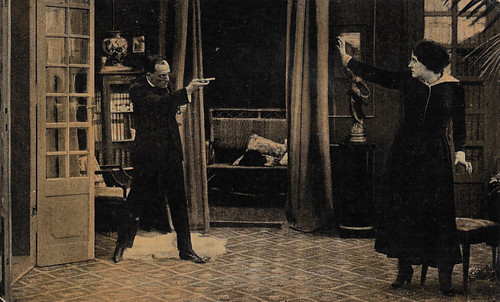
Spanish collector card by Chocolate Pi, Barcelona, no. 6 of 6 cards. Photo: Tiber Film / J. Verdaguer. Hesperia and Emilio Ghione in Il potere sovrano/Temporal Power (Baldassarre Negroni, Percy Nash, 1916). The Spanish title on the cards is Poder Soberano.

Spanish cromo card by Chocolate Imperiale, Barcelona, no. 1 of 6 cards. Photo: Tiber Film / Dist. J. Verdaguer. Hesperia and Tullio Carminati in La donna abbandonata/The Abandoned Woman (Baldassarre Negroni, 1917).

Spanish cromo by Chocolate Imperiale, no. 6 of 6 cards. Photo: Tiber-Film / Dist. J. Verdaguer. Hesperia in Jou-Jou (Baldassarre Negroni, 1916). The film set reminds us a bit of cloisters such as the Chiostro del Paradiso in Amalfi.

Possibly a Turkish or Egyptian postcard. Hesperia as Casque d'Or in Anime buie (Emilio Ghione, 1916). See also Silents, please.
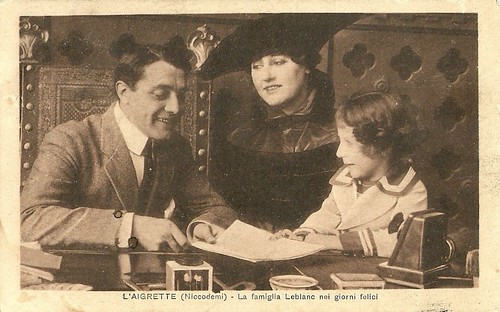
Italian postcard by IPA CT Duplex, no. 5107. Photo: Tiber Film, Roma. Hesperia and André Habay in L'aigrette/The Egret (Baldassarre Negroni, 1917). Caption: 'The Leblanc family in happier days.'
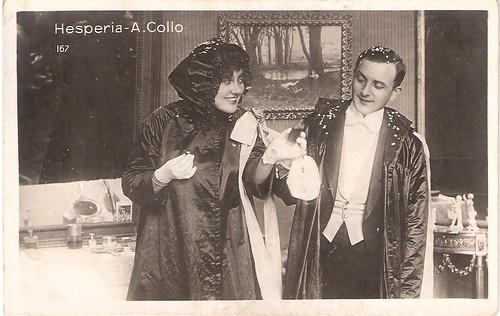
Italian postcard by Ed. Vettori, Bologna, no. 167. Hesperia and Alberto Collo in La cuccagna (Baldassarre Negroni, 1917). In the end, money triumphs instead of love, just as in Emile Zola's novel, 'La curée'. That's why some Italian critics thought the film title La cuccagna/The Bonanza (Abundance) was too cheerful, while 'La curée' literally means 'The Loot' and the official English title of the novel is 'The Kill'.

Spanish collectors card in the Colec. cromos cinematográficos by Chocolat Imperiale, no. 5 in a serie of 6 cromos. Photo: Tiber-Film, Roma / J. Verdaguer, Barcelona. Hesperia in La principessa di Bagdad/The Princess of Bagdad (Baldassarre Negroni, 1918).

Spanish collectors card the Colec. cromos cinematográficos by Chocolat Imperial, Series of 6 'cromos', no. 5. Photo: Grandes Exclusivas Verdaguer / FAI. Hesperia and Tullio Carminati in Vertigine/Vertigo Love (Baldassarre Negroni, 1919).

French postcard by Le Deley, Paris. Photo: U.C.I. / Gaumont / Tiber Film. Publicity still for the Italian silent film Il figlio di Madame Sans-Gêne/The Son of Madame Sans-Gêne (Baldassarre Negroni, 1921). Adapted from the novel by Emile Moreau. The women here may be Hesperia and Pauline Polaire (Mme Ambzac).

Italian postcard. Photo: Tiber Film. Hesperia and probably Carlo Troisi in La belle Madame Hebert (Baldassarre Negroni, 1922). The film was an adaptation of the homonymous French play by Abel Hermant.
Uncontrollable rages
In 1914, Hesperia switched to Milano-Films, with her future husband, film director Baldassarre Negroni. He had already been directing her at Cines. For a while, he was also the artistic director at Milano.
Among their films for Milano were L'ultima battaglia/The Last Battle (Baldassarre Negroni, 1914) with Livio Pavanelli, Vizio atavico/Atavistic Vice (Baldassarre Negroni, 1914) starring Mercedes Brignone, and Nel nido straniero/Stranger in the nest (Baldassarre Negroni, 1914). In 1915, when Italy joined the Allies in the First World War and Milano had to stop producing, Negroni took Hesperia with him to the Tiber Film company in Rome, where Francesca Bertini just had left for the Caesar company.
Strong competition between the two leading ladies started, exploiting both the typical diva repertory of boulevard drama, leading to simultaneous adaptations of Alexandre Dumas fils' 'La dame aux camélias' in 1915. While Bertini remained more solemn, Hesperia could get into uncontrollable rages but also wildly merry moods. In the following years, Hesperia appeared at Tiber Film in such films as Marcella (Baldassarre Negroni, 1915) based on a play by Victorien Sardou, La morsa/The Vice (Emilio Ghione, 1916) and La donna di cuori/The Queen of Hearts (Baldassarre Negroni, 1917) with Tullio Carminati.
Between 1912 and 1923, the year she married Count Negroni and withdrew from the film business, Hesperia made some 70 films, mostly impeccable and often popular bourgeois dramas and comedies. Even later films such as Il figlio di Madame Sans-Gêne/The Son of Madame Sans-Gêne (Baldassarre Negroni, 1921) with her niece Pauline Polaire were known to draw crowds in Italy.
In 1938, the by-now countess Olga Negroni had a small reappearance on Italian screens in the film Orgoglio/Pride (Marco Elter, 1938) starring Fosco Giachetti and shot at the Cinecittà film studios. In 1959, Hesperia passed away in Rome, Italy. The countess was 73.
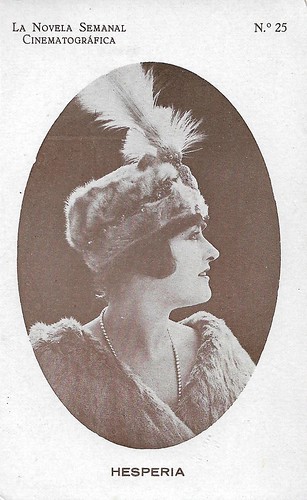
Spanish postcard by La novela semanal cinematografica, no. 25.

Swedish postcard, no. 5557.

Italian postcard by Ed. G. Vettori, Bologna.

Spanish postcard by Leonar.
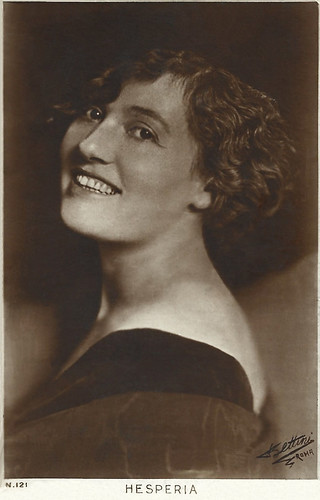
Italian postcard, no. 121. Photo: Riccardo Bettini, Roma.
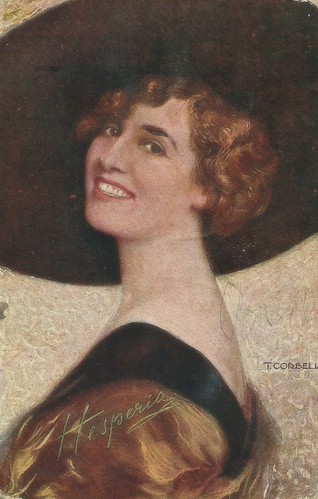
Italian postcard by Uff. Rev. Stampa, Milano, no. 229, 2-4-1917. Hesperia by Tito Corbella.
Source: Vittorio Martinelli ('Le dive del silenzio'), Tonino Simoncelli ('Hesperia, stella del varietà e diva del muto' - in Griffithiana, Issues 55-56), and IMDb.
This post was last updated on 11 September 2024.
No comments:
Post a Comment